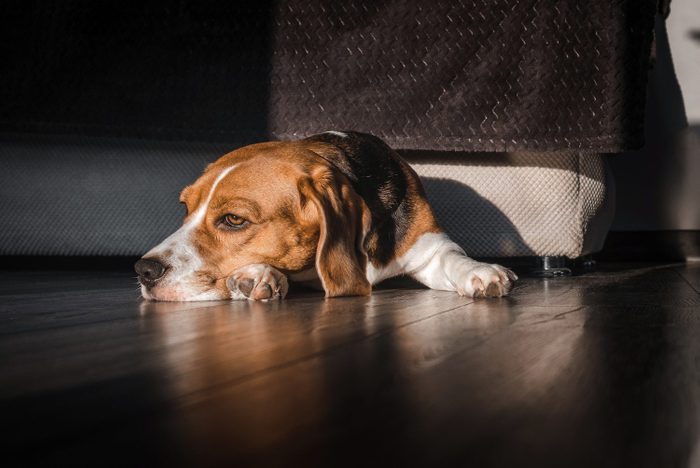
Top signs your dog is feeling depressed
We like to think of dogs as happy-go-lucky creatures that are quick to show joy, but sometimes we notice an expression of sadness or a change in their normal dog behavior that has us wondering: Do dogs cry? Do they develop dog anxiety? Do they develop dog depression? While your pup does experience a range of emotions, including sadness, it doesn’t experience depression the same way humans do, says Linda Simon, DVM, a licensed veterinarian and veterinary consultant for The Pets.
Your dog isn’t staying up at night worrying about the economy or climate change. Still, the things that make your dog sad are often the same types of things that make you sad, like physical pain, loneliness, loss of a loved one, abuse, and neglect, Dr. Simon says. While most canine sadness is brief, sometimes dogs can experience very deep and long-lasting sadness that may turn into dog depression. There are plenty of dog stories that highlight such deep doggy emotions, like the one about the loyal pup who guarded his deceased owner’s grave for three years.
Your dog may also seem depressed if you are depressed, Dr. Simon adds. Dogs are very perceptive of their humans’ feelings, and when you’re sad, your pup may express sadness as well, even if it doesn’t understand why you are upset. Dogs have unique ways of expressing their sadness, so to help you understand your fur buddy better, we asked experts to share the top dog depression symptoms.
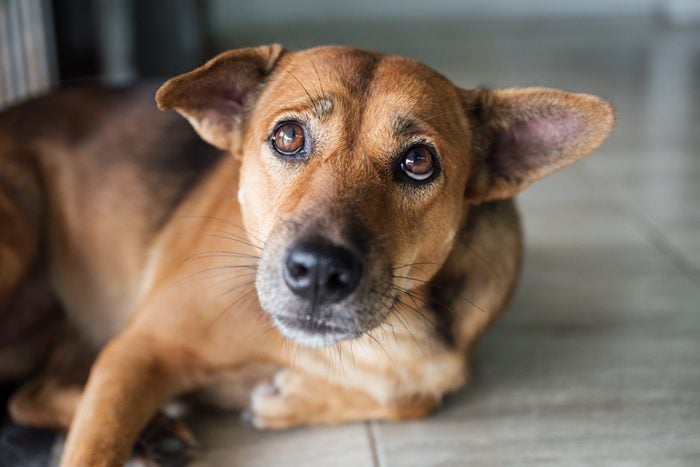
What makes dogs sad?
Like humans, dogs are complex creatures. And like humans, they can become sad for a number of reasons. When considering whether your pup has canine depression, ask yourself if your pet is dealing with any of the following scenarios.
Experiencing a death in the family
You’re not the only one mourning the loss of a family member or another pet. Your dog needs to grieve, too, and might go through a blue period. You can’t really speed up the grieving process, but you can give your dog what it most wants: comfort. Shower your pet in attention—think extra cuddles and treats—while it gets used to the loss, Dr. Simon says.
Moving to a new home
Don’t be surprised if your dog has been acting strange ever since you moved homes. Change can be tough for animals, and your dog might feel depressed while it gets used to its new environment, says Dr. Simon. With a little time and attention, though, your pet should snap out of it and warm up to its new surroundings. While your dog may hate these things, it doesn’t actually hate your new house.
Being left home alone
Your dog probably gets lonely when you’re gone, so if your job constantly keeps you out of the house for long periods of time, your pet might stop jumping up to see you the minute you come home. Dogs are social beings, and they’re not content with being alone for many hours.
First, know how long you can leave a dog home alone. Then do what you can to make sure your dog isn’t left solo for too long—hire a dog walker or ask the usual walker to add another walk to your pet’s schedule, suggests Virginia-based veterinarian Katy Nelson, DVM.
Spending too much time inside
Dogs need space to run around and might become sad if they haven’t been given the chance. Staying indoors all the time, away from nature and sunshine and friends, can take a serious toll on both human and canine mental health, says Dr. Simon.
Know how much exercise your pup needs. Then take the time to bring your dog on long walks or to the park—it’s good for both of you! Once your pet starts getting the freedom it craves, it might slowly get its energy back.
Learning what makes your pup upset is a good first step. From there, it’s important to recognize the signs of depression in a dog. Keep reading to learn the most common dog depression symptoms, according to our experts.
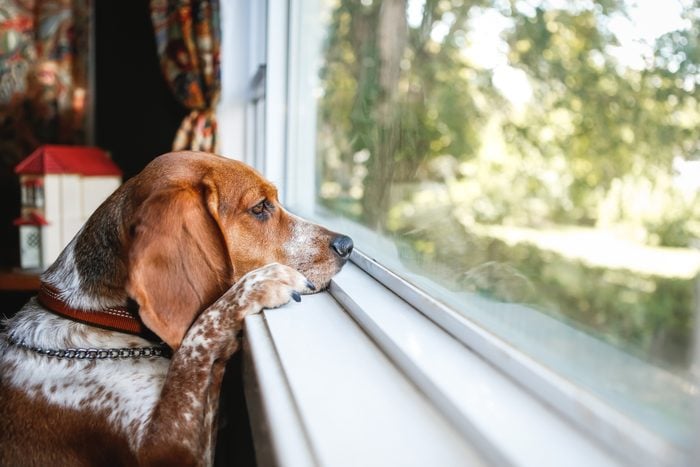
1. Losing interest in its favorite activities
Not every dog loves throwing a Frisbee or going for walks, so lack of exercise might not be the only telltale sign of dog depression. The key is to notice if your sad dog has had an unexplained behavior change or stops enjoying activities it used to love, says Kelly Ryan, DVM, director of veterinary services at the Humane Society of Missouri’s Animal Medical Center of Mid-America.
“Maybe every day your dog waits by the door for your kid to come home from school,” she says. If your pet is still moping in its dog bed after the bus drops your kid off, it might be depressed.
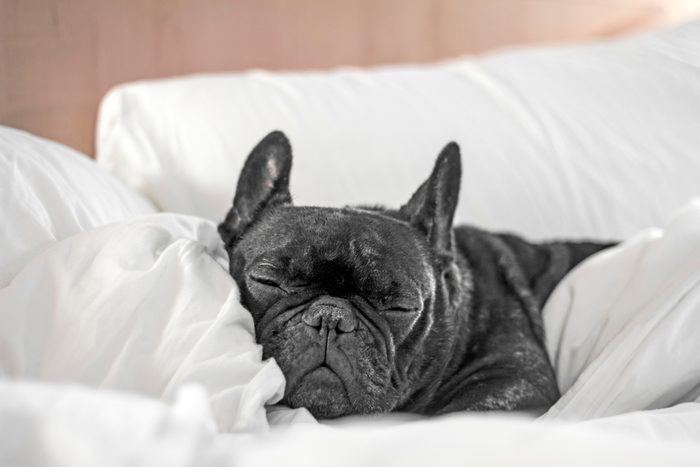
2. Sleeping more than usual
Every animal is different, so there’s no set number of hours your pet will sleep per day if it has dog depression. Just pay attention to whether your dog is spending more time in bed than usual.
“If your 15-year-old dog normally sleeps 14 hours a day, and now it’s 20, that would be a big difference,” says Dr. Ryan. And speaking of sleeping, here’s your answer to the question of what dogs dream about.

3. Leaving food in its bowl
Canine depression manifests in a manner similar to human depression, so just as you might lose your appetite when you’re feeling down, your sad dog might not feel like eating either. If your dog doesn’t show its usual eagerness for its favorite food or even loses weight, it might be experiencing depression, says Dr. Simon. Or it may be upset with you.
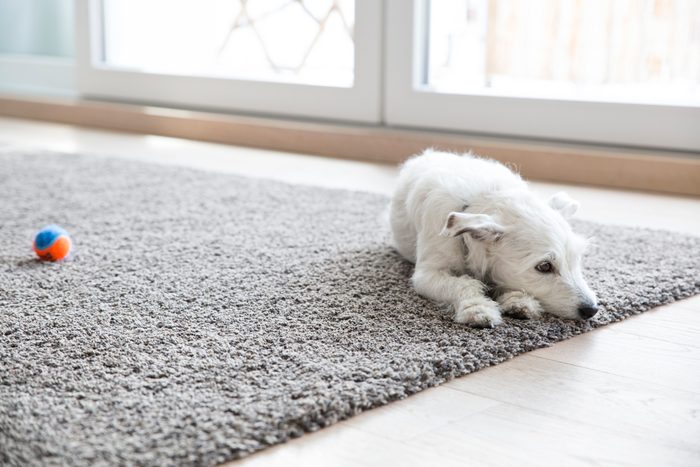
4. Ignoring playtime
Sadly, dog depression is a very real issue. A depressed or sad dog won’t have the same energy levels that it used to, and it won’t be as excited about playtime or exercise. “It could be that their favorite thing in the world was to throw a tennis ball, and all of a sudden, they don’t want to do that,” says Dr. Nelson.
If your dog usually goes wild for its favorite squeaky toy but now only regards it with mild curiosity, it may be too depressed for play.
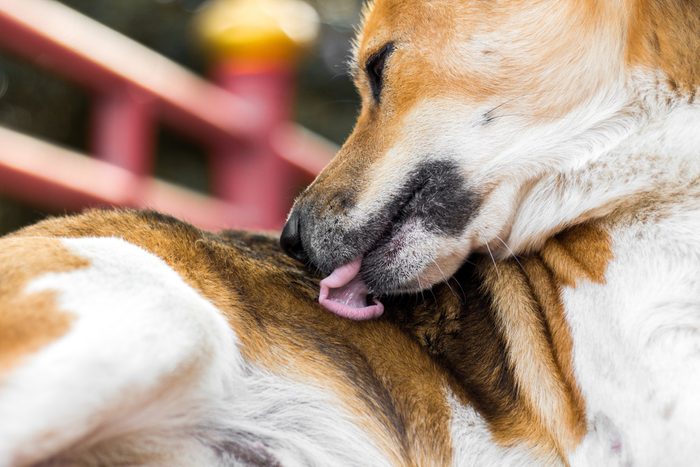
5. Licking constantly
Animals don’t just lick themselves to get clean; sometimes they use the action to make themselves feel better. While it’s not a common symptom of dog depression, it isn’t unheard of, says Dr. Ryan. “If dogs have anxiety issues, they could be doing more compulsive-licking behaviors that can be self-soothing,” she says. “They pick a spot and keep licking it.”
So if you spot your dog licking its paws on repeat, you may want to keep a close eye out for other signs of doggy depression.
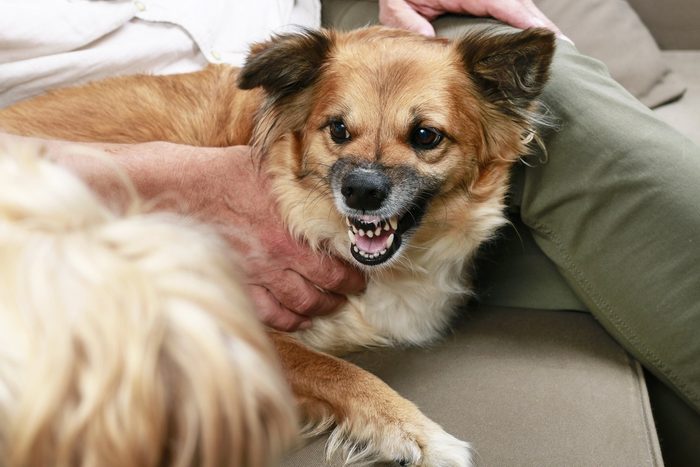
6. Showing sudden aggression
A dog with depression might start tearing up the couch or growling when you touch it. “It’s not always the sad, forlorn basset hound–looking face you think of as the face of depression,” says Dr. Nelson. Depression shouldn’t be your first thought if your dog has always been aggressive, but a cuddly pooch that suddenly snaps might be telling you something’s wrong.
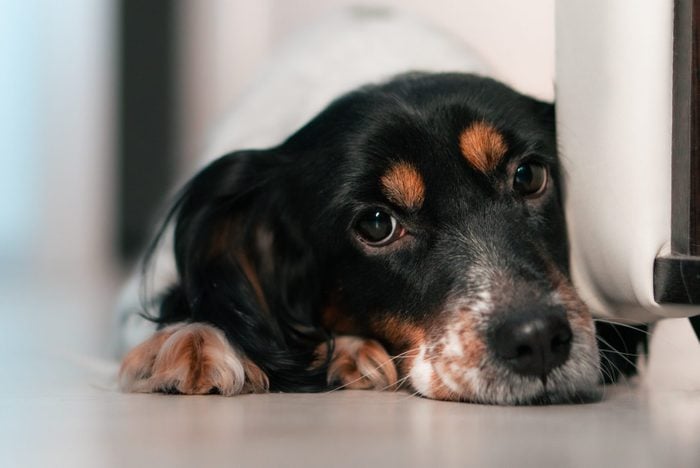
7. Whimpering or whining
Puppies instinctually use these noises to communicate with their mother, and they may continue this method of “crying out” as adult animals, particularly if you respond to it, Dr. Simon says. Getting to know your dog’s communication style is one of the things great pet owners do.
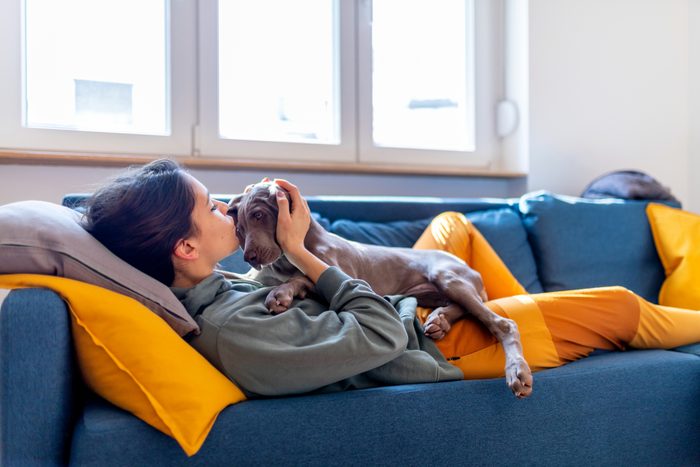
8. Needing extra snuggles
It’s normal for your dog to seek comfort from you when feeling depressed. This is often the case if its sadness is related to feelings of pain, illness, loneliness, or boredom, says Dr. Simon. An overly needy dog may feel annoying or surprising, but your pup may be feeling depressed. Take some time to show your dog more affection.
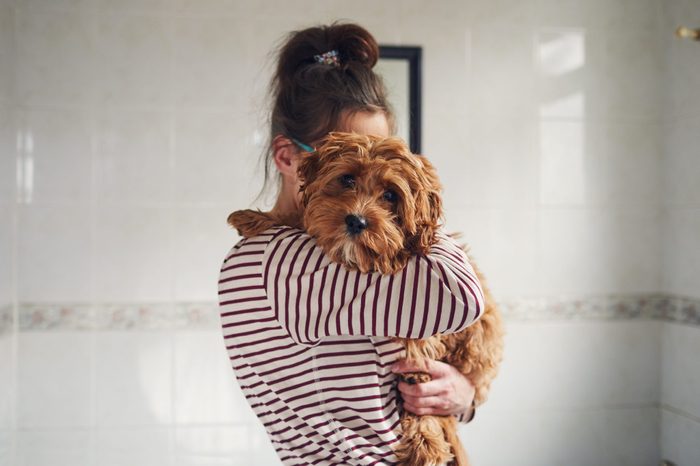
9. Communicating its need for love
The longer you and your furry friend are together, the more you develop special ways of communicating, unique to the two of you. With time, you should be able to interpret your dog’s facial expressions, actions, and sounds.
This means you are the one most likely to understand when your dog is sad—and why, says Dr. Simon. Learn to recognize your pup’s personal signs of depression. Maybe it brings you a comfort object, like its blanket. Maybe it makes a particular noise or taps you with its paw. The important thing isn’t how your dog is showing sadness but rather that you understand it—and then give extra love.
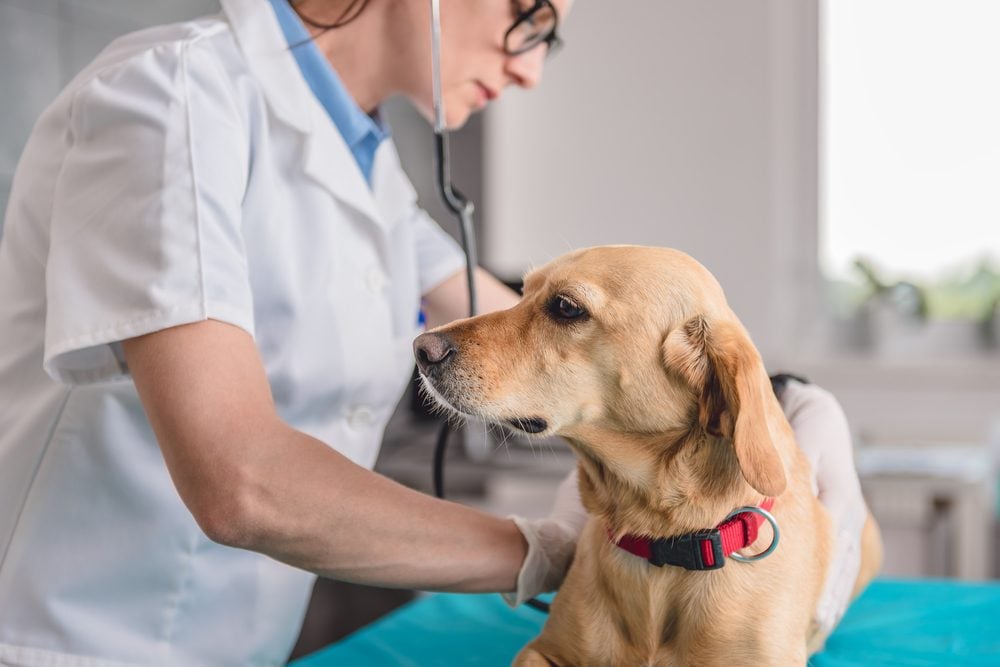
What to do if your dog is depressed
There’s a good chance you’ve spent less time wondering, “Can dogs be depressed?” or even, “Is my dog depressed?” and more time asking yourself, “What can I do to help?” First, before you blame your dog’s behavior on depression, a vet will need to do a full checkup. What you think are signs of depression in your dog may actually be symptoms of an illness, like a thyroid problem or an indication your pup is in pain.
A vet who has ruled out other health issues will likely recommend you give your dog more exercise, a healthier diet, and extra attention to lift its spirits. As a last-ditch effort, a vet might prescribe a sad dog one of the same depression medications humans would use, such as Prozac or Zoloft.
“We don’t want all our dogs walking around on Zoloft if we don’t have to, and oftentimes we don’t need to,” says Dr. Nelson. “But if giving that little something to take the edge off helps them live a more comfortable life, there’s no shame in that game.”
Additional reporting by Marissa Laliberte
Sources:
- Linda Simon, DVM, a licensed veterinarian and veterinary consultant for The Pets.
- Katy Nelson, DVM, Virginia-based veterinarian
- Kelly Ryan, DVM, director of veterinary services at the Humane Society of Missouri’s Animal Medical Center of Mid-America
